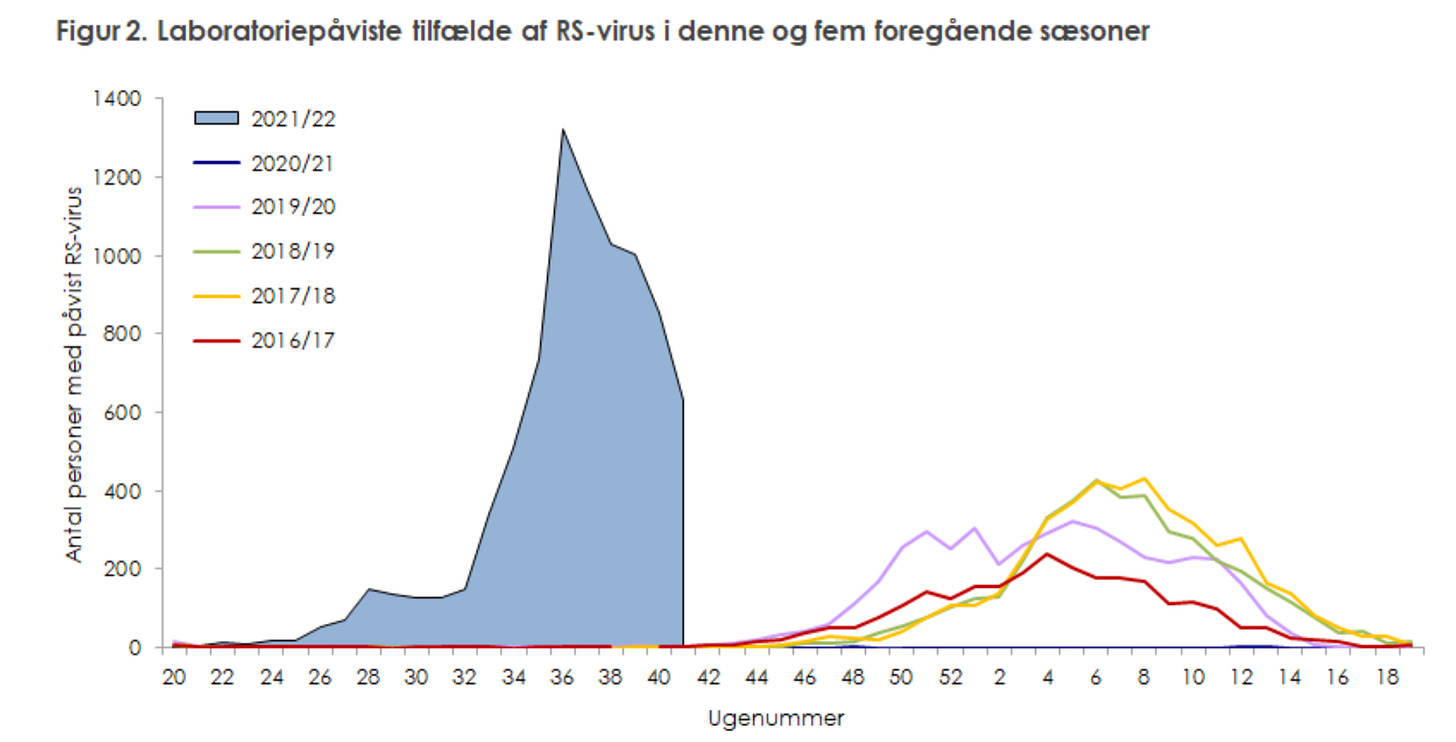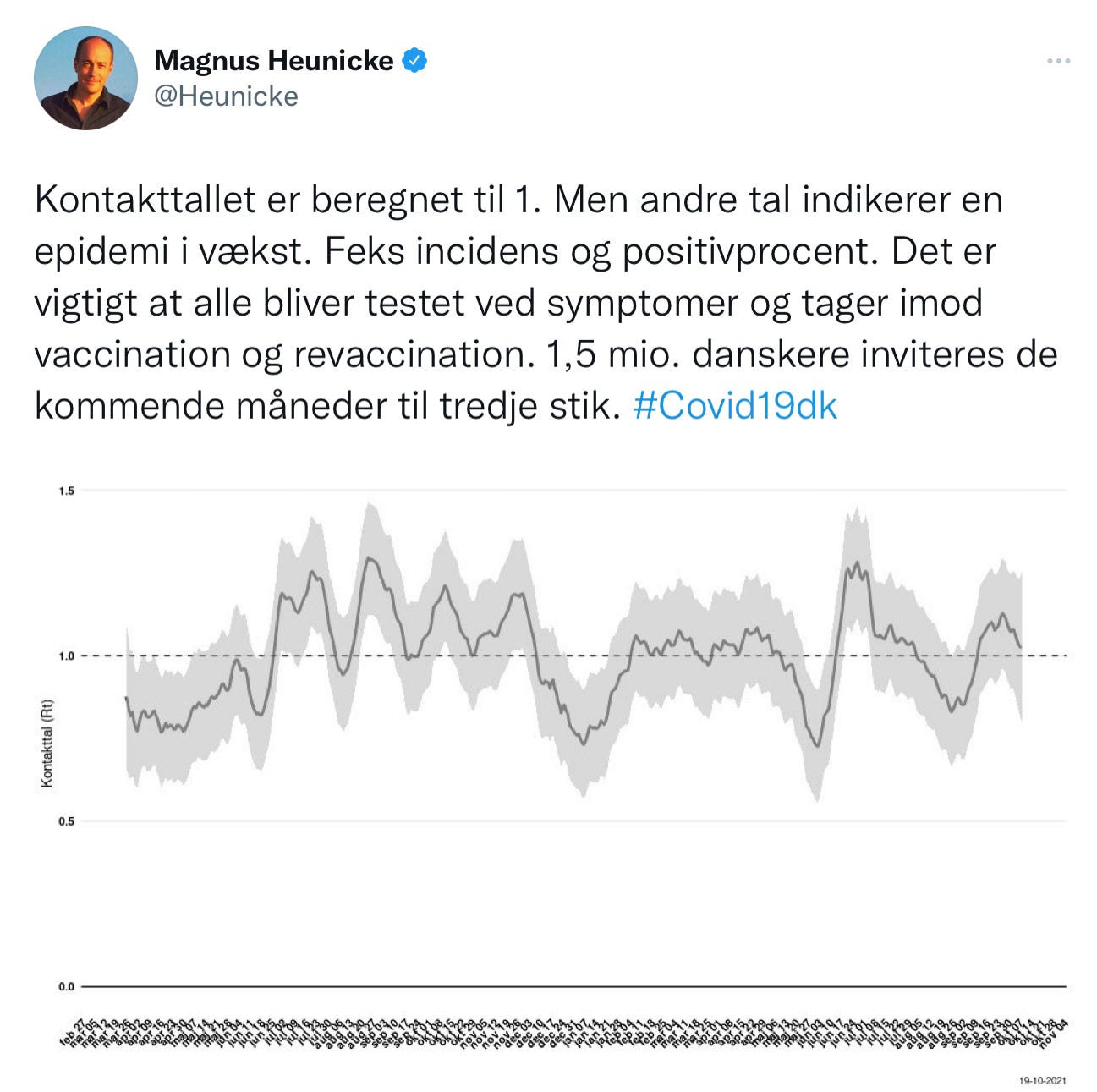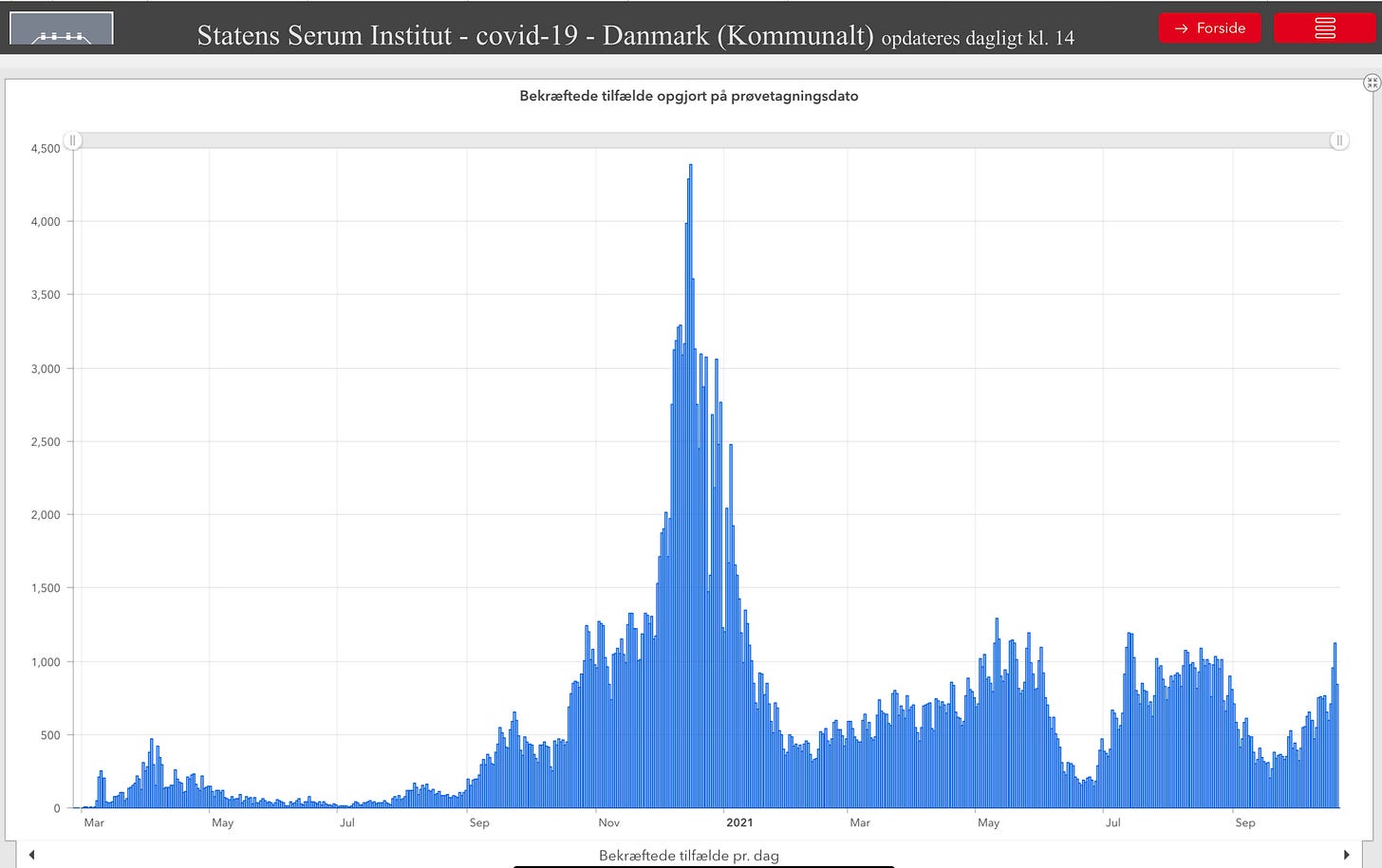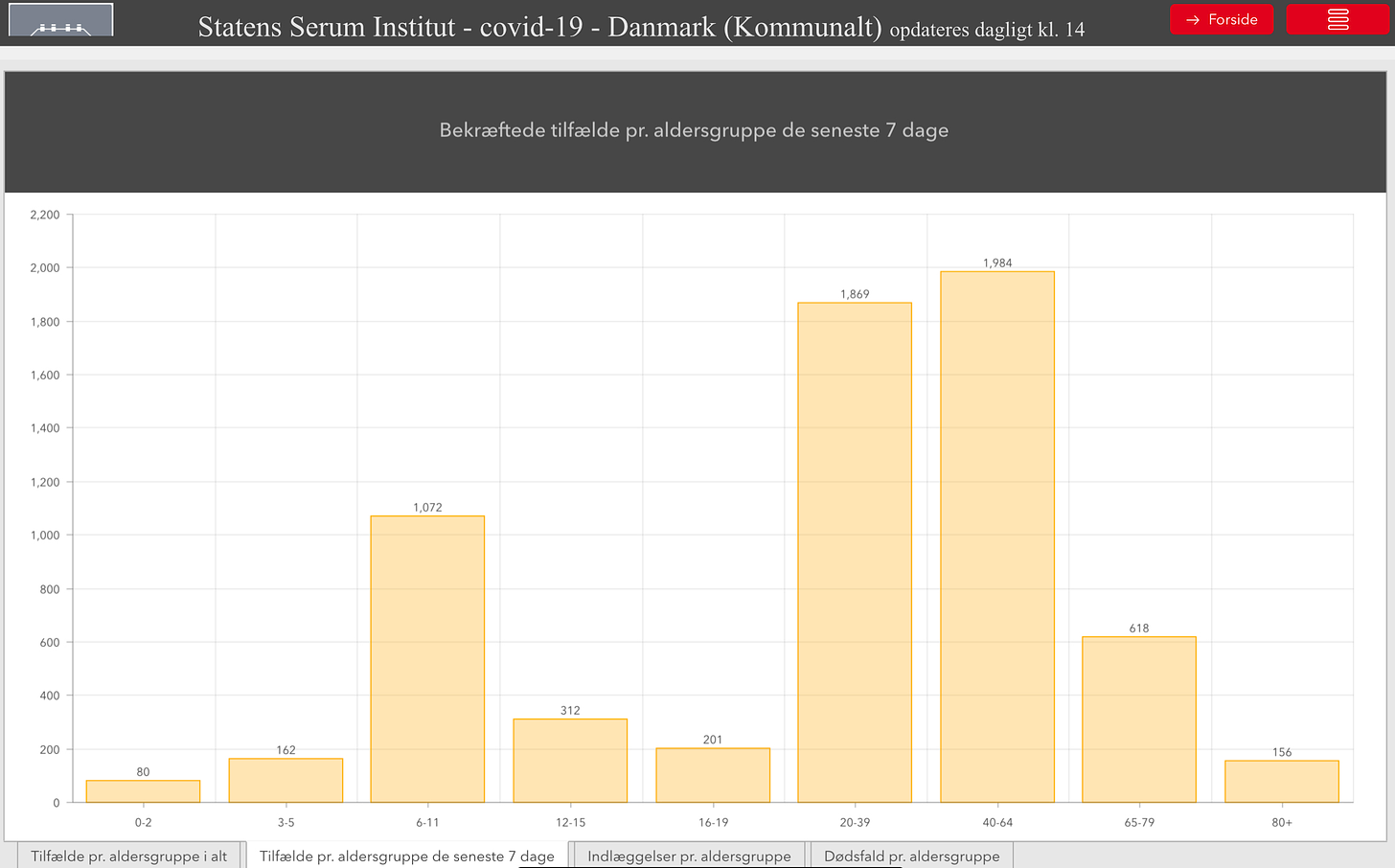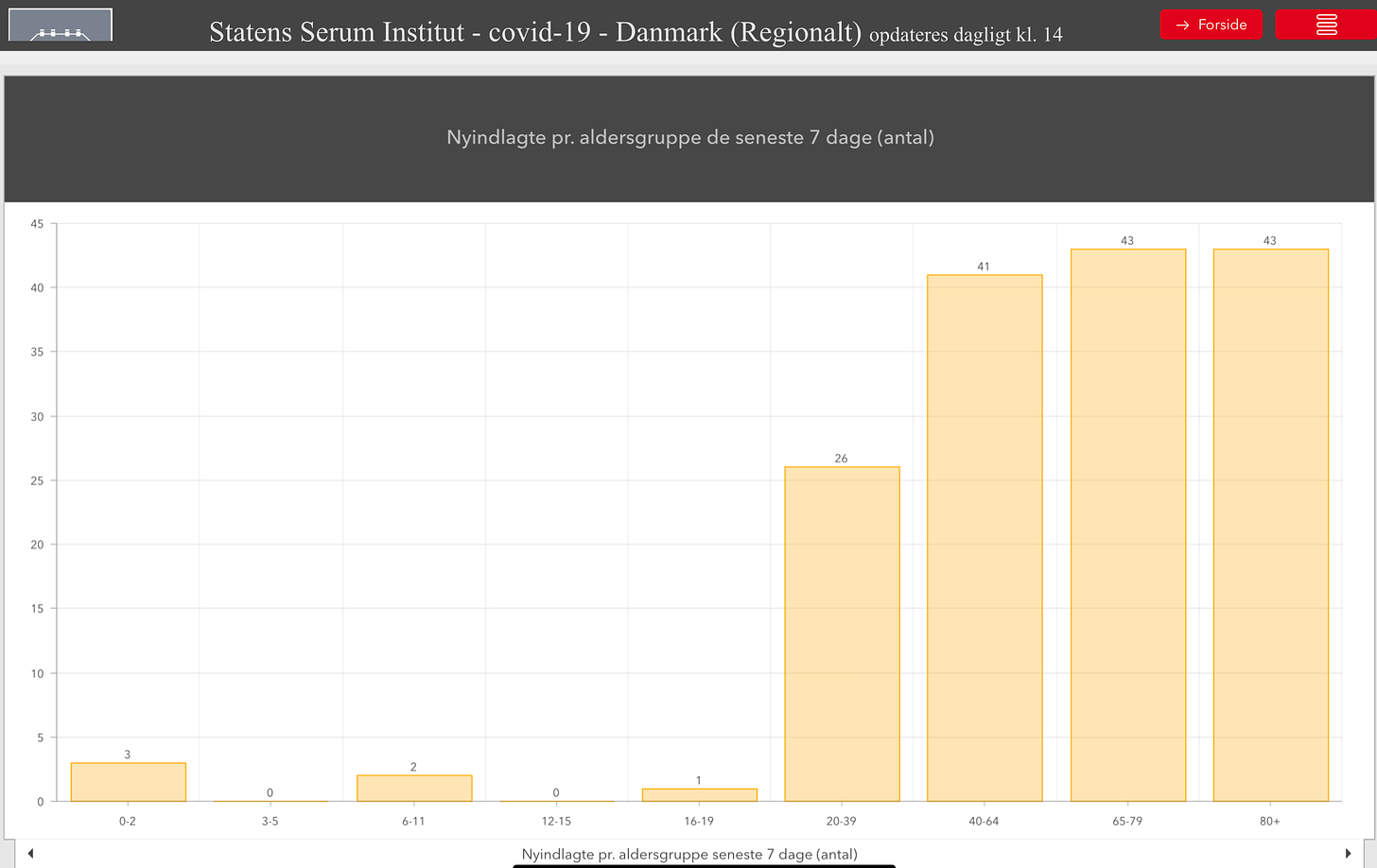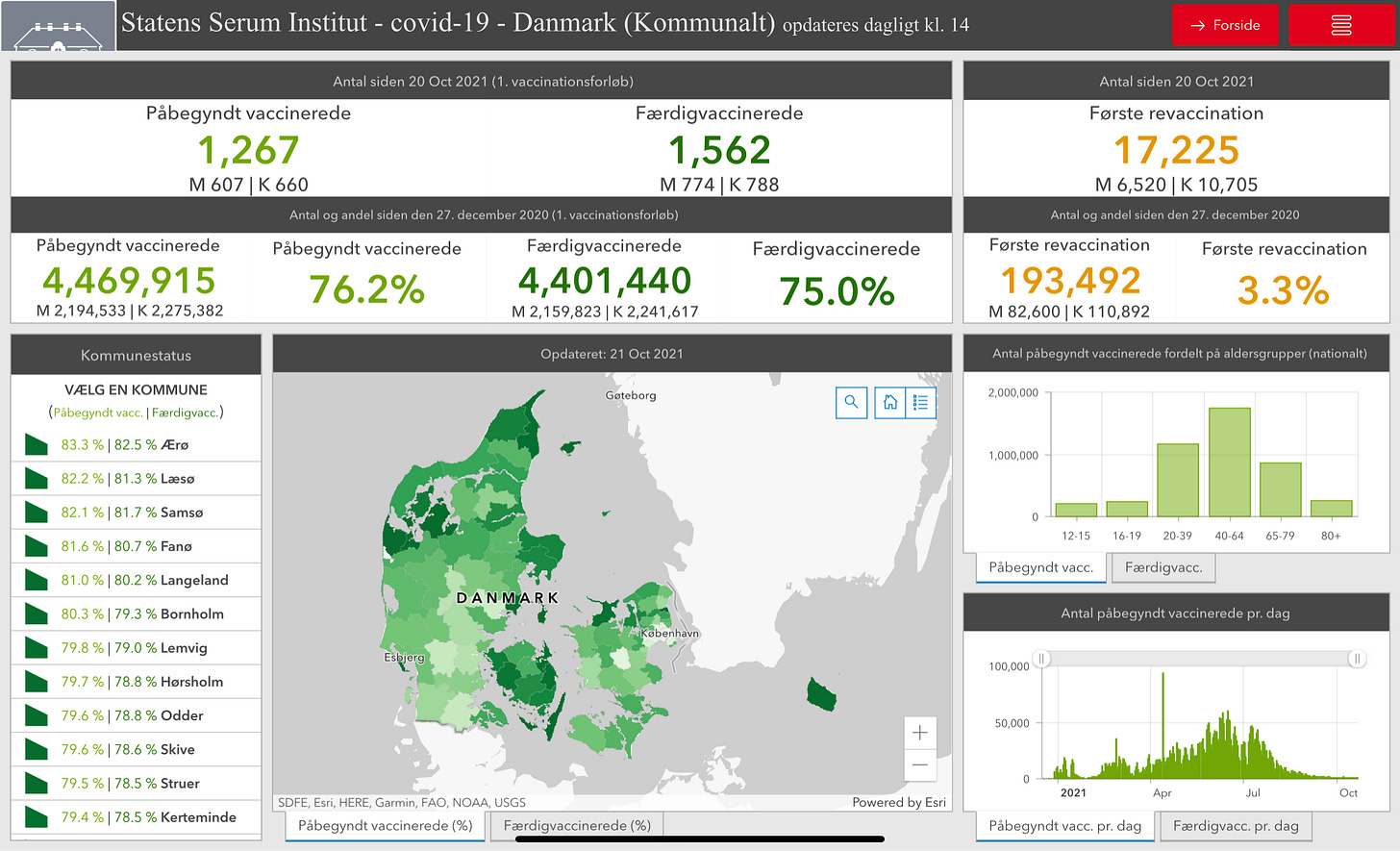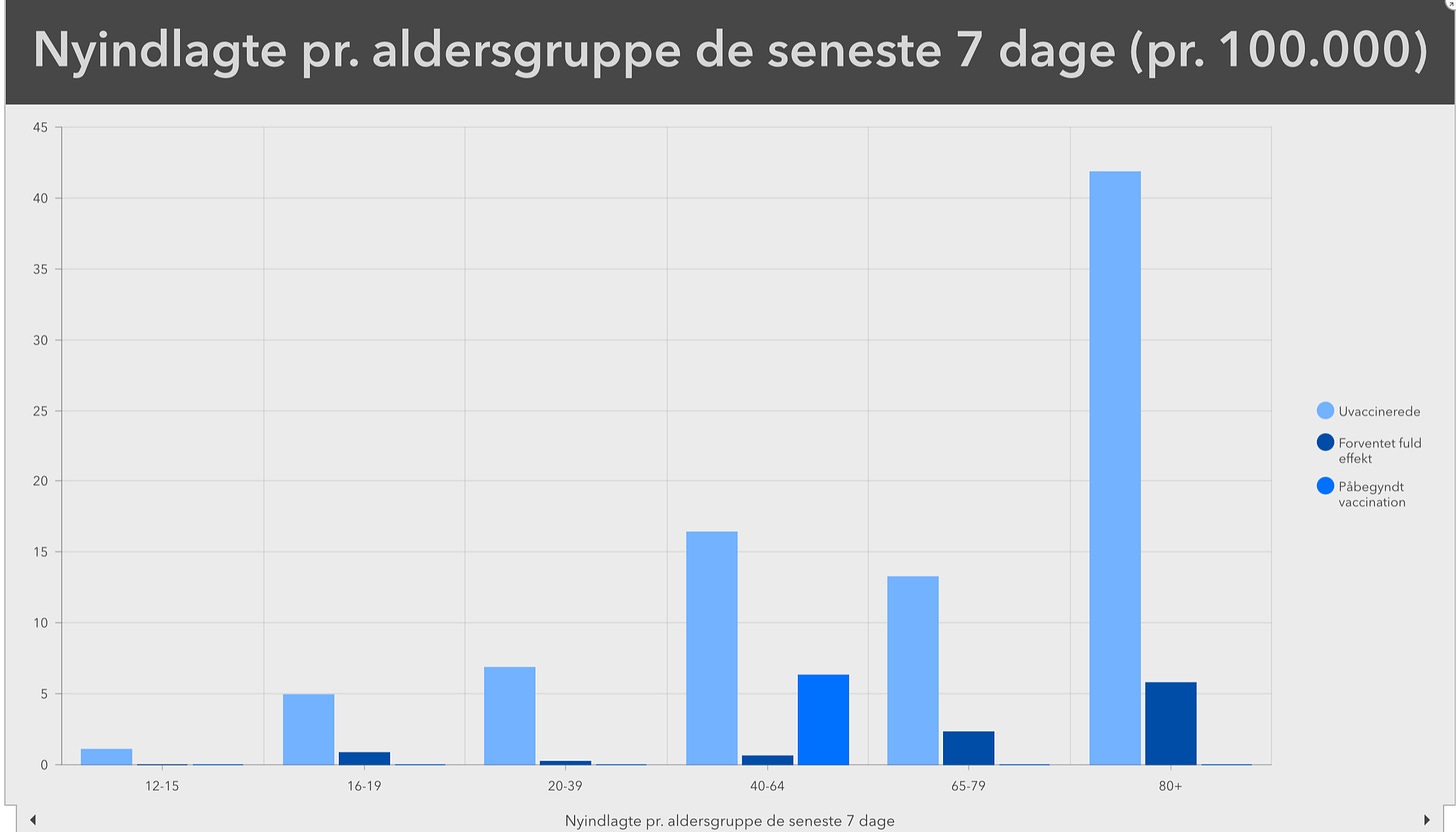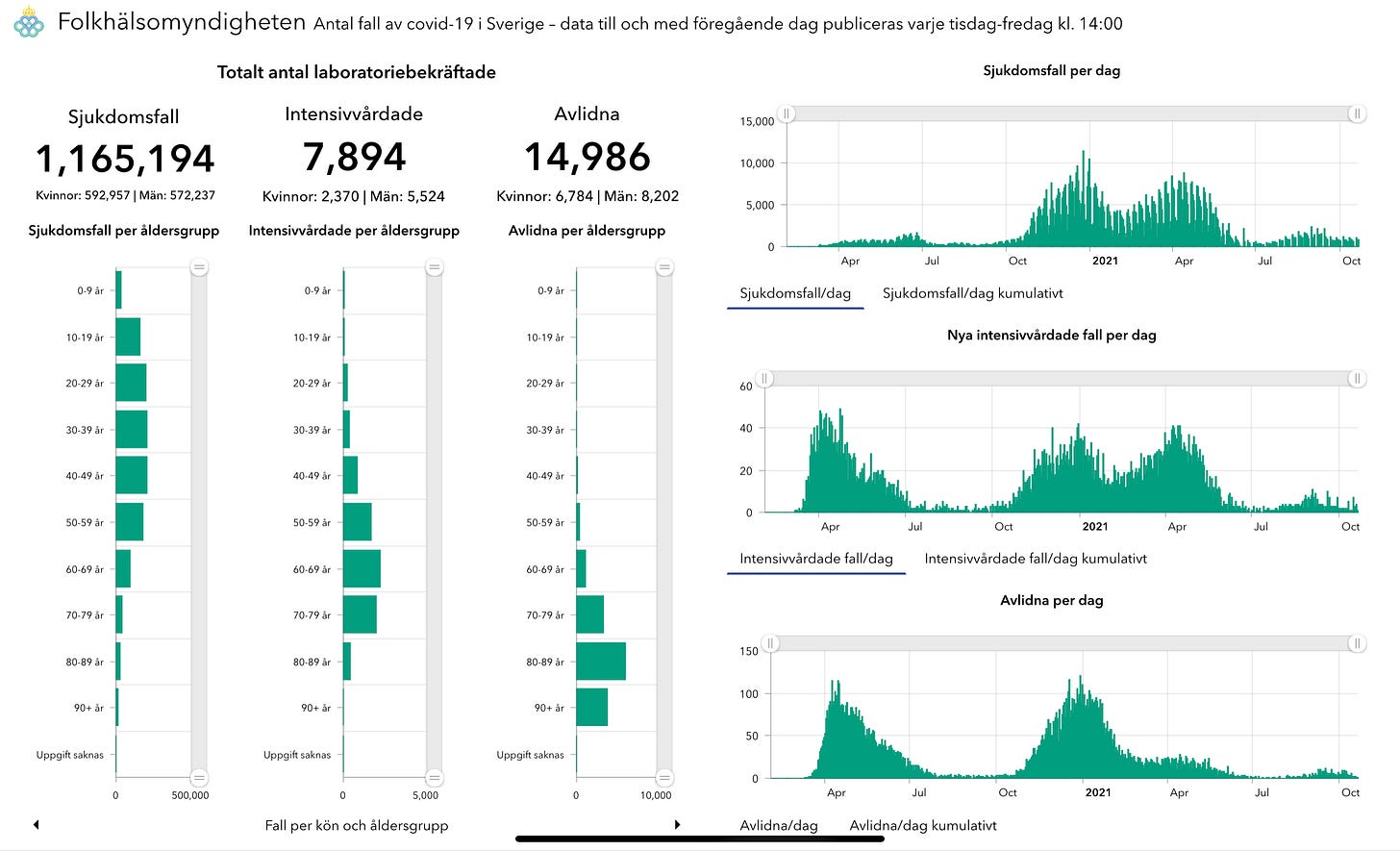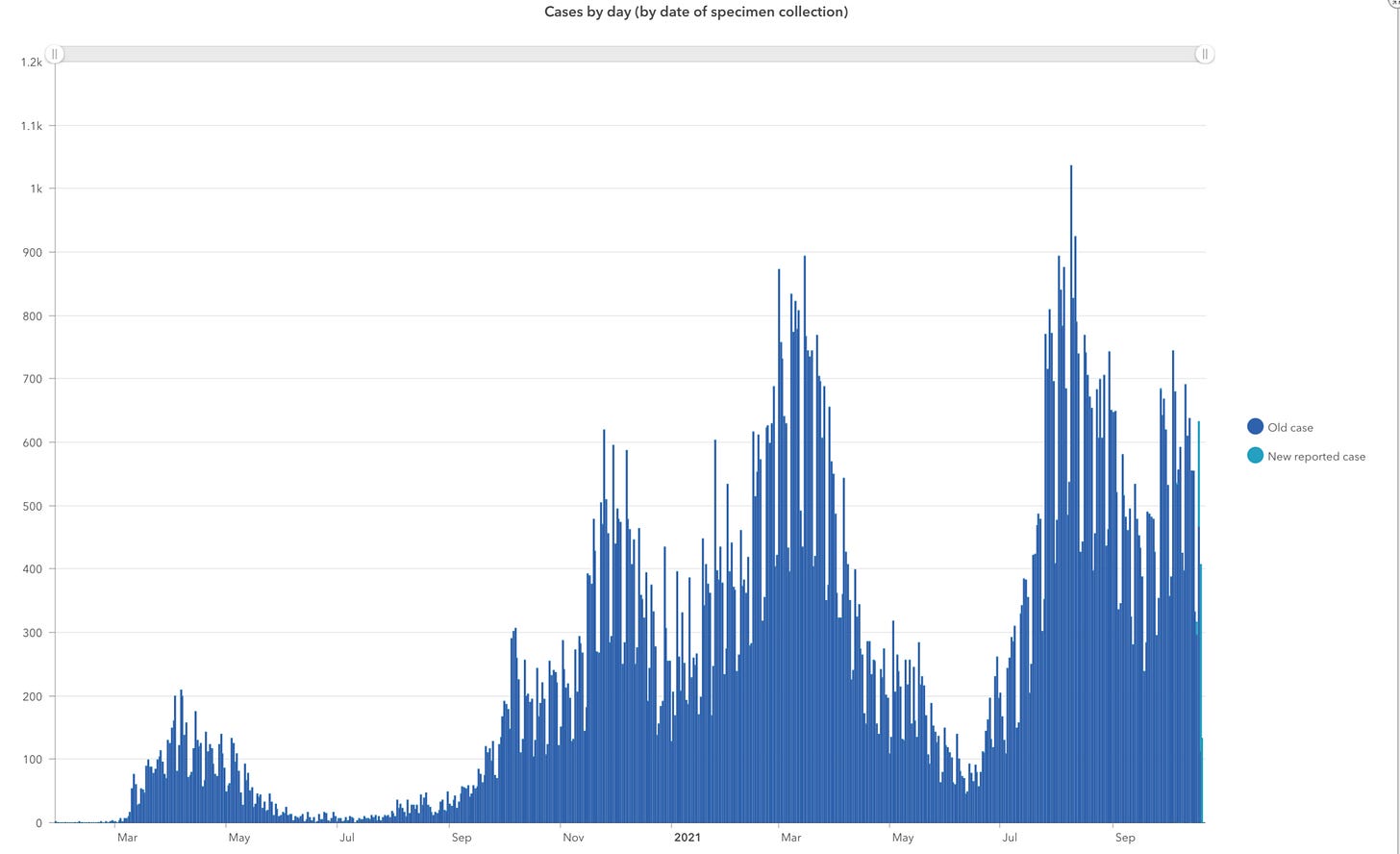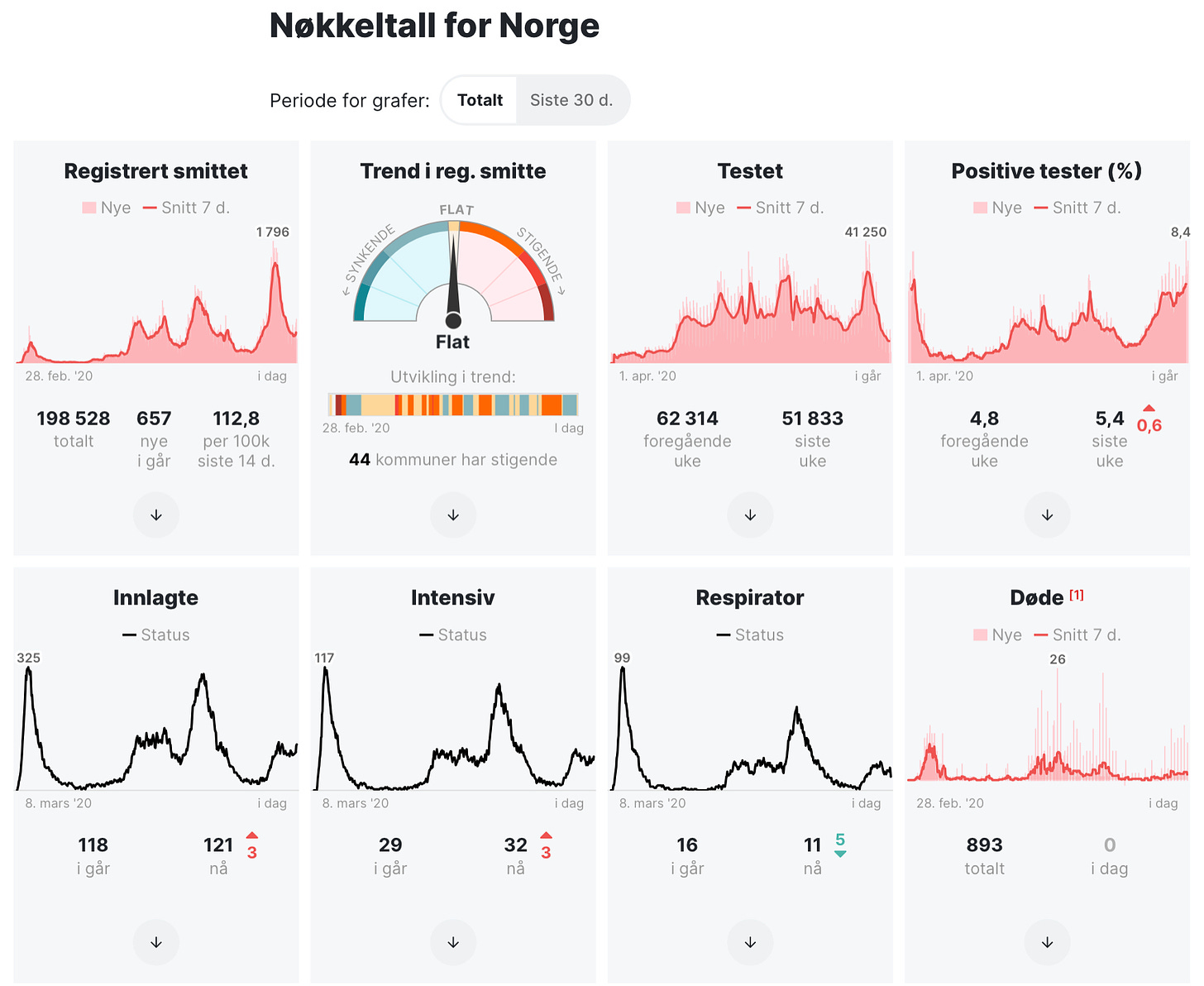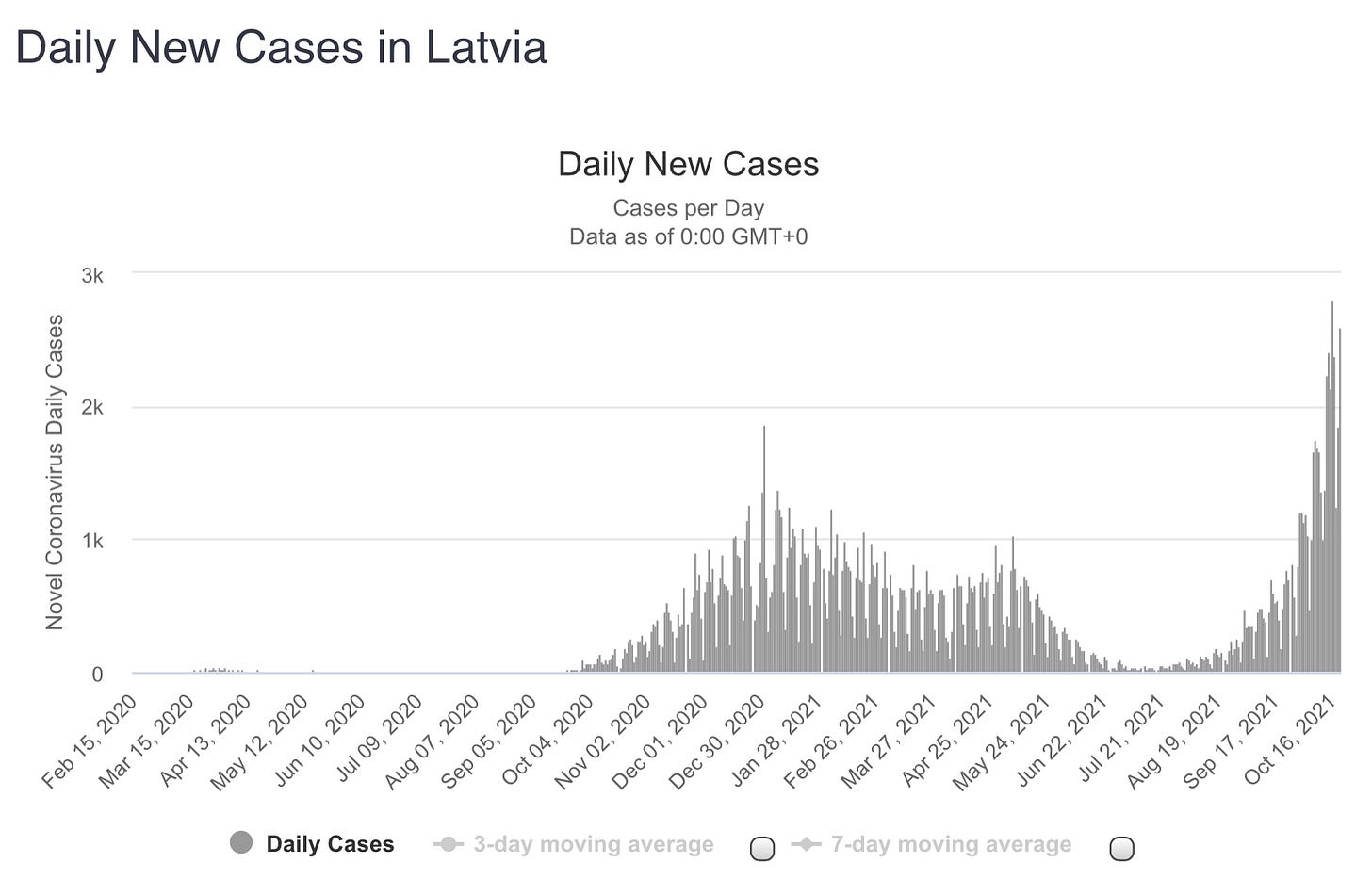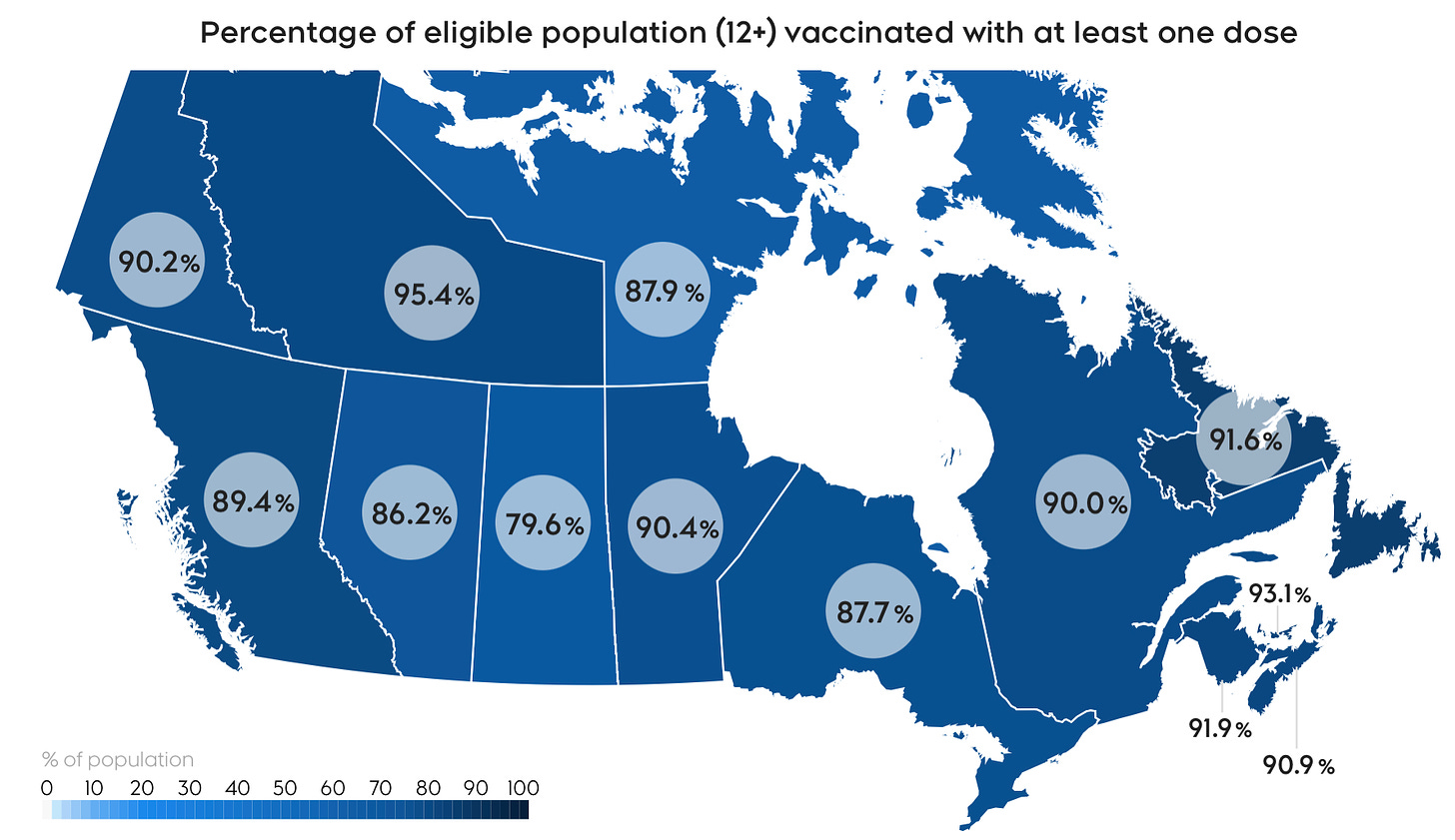🇩🇰
There were 632 people who tested positive for the RS Virus last week, down from 848 the week before and over 1,000 for the four weeks prior to that. While numbers have continued to drop for a fifth straight week, the Staten Serum Institut says overall infection activity remains three to four times higher than ever seen before in the country.
Below is a graph from the SSI charting current RS Virus activity versus trends from previous years.
The virus presents as a cold but then moves into the chest. For very young children it can be very dangerous and causes breathing problems and often hospitalization.
-
For a third straight week, Denmark’s COVID contact number (reinfection rate or R0) remains at 1.0. However, Health Minister Magnus Heunicke warns that “other numbers indicate a growing epidemic.”
-
The expert group on mathematical modeling is out with its latest forecast. Its latest modeling shows a worst case scenario of infection activity increasing up to 3,200 new COVID cases per day by mid-November, with as many as 110 new hospital admissions each day. However, the panel says there are some big unknowns including the fallout from the October holiday week and the impact of the booster dose campaign.
Ultimately, it is anticipating that infection activity and hospital admissions are more likely to skew towards the lower end of the range. That would see something closer to 600 daily cases and around 25 hospital admissions each day.
Panel Chair Dr. Camilla Holten Møller:
“The models show how it will go in a scenario where activity in the community and the vaccination rate both correspond to the level we have now. Based on that, we still expect to see an increase in daily infection rates and new admissions in the next six weeks. But it is also still uncertain how big the increase will be.”
The panel is anticipating the most infection activity to occur among young people and those who are unvaccinated. However, it is also anticipating “a significant number” of breakthrough infections, especially among those 12 to 59 years old.
-
The pandemic situation in Denmark does appear to be worsening. There were 1,247 new COVID cases reported today along with two more coronavirus deaths. This is the fifth consecutive day of increasing case numbers and the second straight day with over 1,000 new infections.
There were 66,275 PCR tests administered yesterday for a positivity percentage of 1.88%.
-
Denmark also continues to see a concerning level of coronavirus activity among children, especially those aged 6 to 11 years old with 1,072 cases in that age group in the last seven days.
Thankfully, the infection activity among young children has not translated into any surge in hospital admissions. In the last seven days, there were just six total hospitalizations among those aged 19 years old and younger.
-
There are now 34 Danish kommunes with a COVID incidence rate above 100 per 100,000 residents, and of those 15 have incidence rates above 200 and one, Ishøj, is above 300.
In 25 of those municipalities, the infection incidence rate is trending upwards.
-
COVID hospitalizations (132) continued to push upward (+6) while the number of infected people in an ICU (14) also edged up (+3) and of those the number on a ventilator (8) is unchanged day to day.
While the number of coronavirus hospitalizations has risen above 100, again, one expert is cautioning that this is to be expected with no COVID restrictions.
But speaking to Ritzau Viggo Andreasen, associate professor of mathematical epidemiology at Roskilde University, says the numbers are not at a level where the restrictions would need to be reintroduced.
“Some of what we are seeing now, with a week to ten day delay, is an increase in admissions because the epidemic is growing. Some of the admissions are among younger people. This is what we should expect when we have opened up society and the epidemic shifts its focus to younger people and those who are unvaccinated.”
_
More and more people in Denmark are foregoing getting a COVID test and instead turning to their doctor when they get sick. The problem has increased to the point that the Danish Society for General Medicine has had enough.
Society Chair Anders Beich spoke to DR, saying people need to go get tested.
“It seems that more than half of those who call in have not been tested because they either have not thought about it, or they think it was too innocent to be tested.”
Doctors are concerned that if people do not get tested right away when they get sick and if they do have COVID, they risk infecting others.
-
On the vaccination front, Denmark has hit another milestone. 75% of the total population is now fully vaccinated and 76.2% of people have had at least one vaccine dose and 75% are fully vaccinated.
Booster doses now make up the lion’s share of daily vaccinations with 17,225 yesterday, while 1st and 2nd doses have slowed to a crawl.
According to the Danish National Health Board, 94.7% of all nursing home residents have now had a booster shot and 71.5% of people who are immunocompromised have also had a third dose.
Beginning next week, people who have had a second vaccination dose more than six months ago can book an appointment for a 3rd booster shot. The Danish National Health Board began sending out invitations this week. This will primarily involve people between 65 and 84 years old, vulnerable populations, and those that work in seniors and healthcare.
-
The Staten Serum Institut is now offering some idea of infection activity between those who are vaccinated and unvaccinated. The agency says the numbers clearly show that the risk of being hospitalized is much greater among the unvaccinated. The SSI says unvaccinated people are also admitted to hospital in significantly higher numbers.
“For every 100,000 people who are unvaccinated and at least 12 years old, there are 7 patients. And by comparison, there are only 1.5 patients for every 100,000 people among those fully vaccinated and at least 12 years old.”
Overall COVID incidence rates per 100,000 people are also 3.7 times higher for unvaccinated people.
-
Breakthrough infections are rising but overall remain a very small portion of those who are fully vaccinated. An update from the Staten Serum Institut says as of October 12th there have been 16,105 breakthrough infections, which equals 0.4% of all fully vaccinated people.
According to the latest report from the SSI there have been 17,554 infections after one vaccination dose and 16,105 among those who have had both doses.
Acting Head of Department Palle Valentiner-Branth:
“Overall, we are seeing an increasing number of breakthrough infections. But it is expected when the number of fully vaccinated people in the population increases.”
-
Good news and bad news on the Danish labour front. The good news is that Denmark’s economy is on a bit of a tear despite the pandemic. For a seventh month in a row employment numbers have increased. According to Statistics Denmark, another 15,000 people joined the workforce last month, pushing employment numbers to record highs. However, the bad news is that Denmark seems to be seeing a shortfall of workers in some growing industries. Sydbank's Chief Economist Søren Kristensen is the latest to raise a warning saying the Danish economy “is now severely threatened by a shortage of labour.”
🇸🇪
Sweden has added 792 infections and one more corona death since yesterday’s update.
The Swedish vaccination effort has administered 7,229,925 1st doses (84.6% of its population 16 years old and older) while 6,835,369 people (80%) have had both doses.
It is tracking the inoculation rate among 12 to 15 year olds separately and 61,430 first shots (12%) have been doled out so far.
-
The Swedish Health Agency is extending a decision to only use Pfizer/BioNTech vaccine doses for people 30 years old and younger. The mandate also includes people in the age group who have had a first dose of the Moderna vaccine who will now receive Pfizer as their second shot. The agency made the change over fears of rare side effects impacting the heart.
🇫🇮
Finland has registered 608 infections today and added another 13 virus deaths.
According to data from the Finnish Institute for Health, the country has recorded more COVID deaths this year than in 2020. So far this year, Finland has lost 572 lives to the pandemic. Last year, the country recorded 561 total corona deaths.
To date, 4,191,266 1st doses have been administered (74.7% of the total population) and 3,738,994 people (66.9%) have been fully vaccinated.
-
According to a report from YLE Finnish prosecutors have filed the first-of-its-kind charges in Helsinki court against three defendants who refused to take a COVID tests upon arriving in the country. Finland has the ability to lay charges due to a temporary provision in its Communicable Diseases Act. People “who intentionally or through gross negligence fail to take a COVID test” can face charges.
🇳🇴
Norway has added 657 infections and had no new deaths in the last day.
COVID hospitalizations (121) have inched upward (+3) while ICU numbers (33) also increased slightly (+3) and of those the number on a ventilator (11) also rose (+5).
So far, 77.82% of Norwegians 12 years old and older have had one vaccine dose and 68.93% have had both.
🇩🇰🇸🇪🇳🇴🇫🇮✈️
As of this week, both SAS and Norwegian Airlines have dropped the requirement for passengers to wear a mask but only when traveling domestically within one country or traveling from one Scandinavian country to another. However, mask use is still mandated within airports and on all international flights.
🇱🇻
Latvia began a four week lockdown today. The Baltic nation is among the least vaccinated European countries and it is now seeing record high numbers of daily infections. The lockdown is scheduled to end November 15th if the lockdown succeeds in bending down the country’s surging infection curve.
🇦🇺
The longest COVID shutdown in the world came to an end today as Melbourne, Australia comes out of a 262 day lockdown. The city reached a 70% vaccination rate allowing for some COVID restrictions to be eased. More will be lifted once the city hits an 80% vaccination rate. While bars and restaurants reopen customers must show proof of vaccination to enter. An indoor mask mandate also remains in place.
🇨🇦
Prime Minister Justin Trudeau announced a deal with Pfizer/BioNTech today to purchase millions more vaccine doses that have been specially formulated for young children. The Prime Minister says it’ll ensure Canada has the doses it needs to vaccinate kids between the ages of 5 to 11 once Health Canada gives its approval.
-
Canada reported 2,642 new infections yesterday, along with another 41 lives lost to the coronavirus. Nationally and across most provinces, the latest Delta variant-driven infection wave continues to ease.
So far, the Canadian vaccination effort has administered 29,568,890 1st doses (77.33% of the total population) while 27,865,801 people (72.88%) are fully vaccinated.
In Ontario today there were 413 new infections, of which 273 were among people who were either unvaccinated or who had a single dose. Of 274 hospitalizations 234 are unvaccinated or not fully vaccinated. Among the 161 in intensive care units, that number is 141.
Quebec reported 428 more COVID cases and another three deaths today.
In Atlantic Canada, New Brunswick had 67 infections and two more deaths. Nova Scotia had 19. Newfoundland and Labrador had 9.
Manitoba saw 92 new infections today.
There were 355 new infections in Saskatchewan today. The province has also transferred three more patients to Ontario due to a shortage of ICU beds.
Alberta recorded 770 new corona cases and eight more deaths today. There are 912 people in hospital and 201 in an ICU, of which 87% are unvaccinated.
B.C. logged 715 new infections and four more deaths today. There are 377 people in hospital and 136 in an ICU. Unvaccinated people account for 66.4% of infections and 76.2% of hospitalizations.




